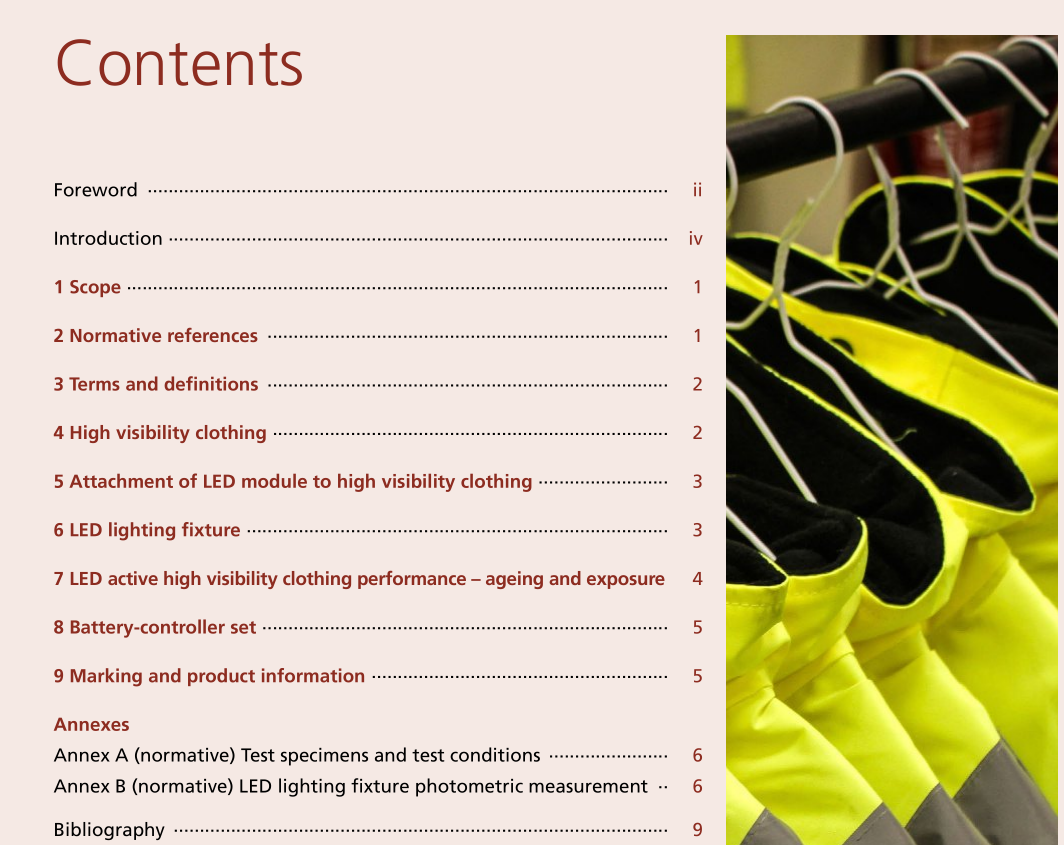PAS 10412:2015 pdf download.Intelligent clothing – LED active high visibility clothing – Specifcation
1 Scope
This PAS specifes requirements for high visibility clothing conforming to EN ISO 20471 incorporating active lighting via Light Emitting Diodes (LEDs). It covers LED modules that are permanently attached to high visibility clothing. It is applicable to an LED lighting fxture having a removable battery-controller set and LEDs measuring between 2 mm and 20 mm in diameter. This PAS covers high visibility clothing that is designed to be subjected to temperatures falling between -30°C and 50°C and is applicable to high visibility clothing used in professional or civil situations. It covers requirements for the luminous intensity of the LED lighting set only, when not including luminous intensity obtained from other lighting or visibility systems that also appear on the high visibility clothing, such as fuorescent material and retrorefective material. This PAS does not cover the requirements of the wiring, e.g. electrically conductive material that is woven into the fabric itself, or fabric made of electrically conductive material. The PAS makes no provision for requirements for LED active high visibility clothing designed for use in fre-fghting, or for protecting against chemical, bio-nuclear, or radioactive situations. It does not cover requirements for the placement or confguration of LED lighting sets on high visibility clothing. Annex A covers requirements for test specimens and test conditions and Annex B covers a test method for an LED lighting fxture photometric measurement. NOTE 1 The temperatures to which the clothing is designed to be subjected includes temperatures expected for cleaning and maintenance of the clothing. NOTE 2 Requirements for fuorescent material and retrorefective material can be found in EN ISO 20471. NOTE 3 Factors related to risk level are given in EN ISO 20471:2013, Table A.1.
3 Terms and defnitions
For the purposes of this PAS, the terms and defnitions given in EN ISO 20471:2013 and the following apply. 3.1 active lighting visible illumination produced by the fow of electrical current 3.2 battery-controller set unit incorporating battery source and lighting controls that attaches to, and detaches from, the LED module (see 3.7) 3.3 high visibility clothing warning clothing (see 3.9) intended to provide improved visibility in conditions where the risk of not being seen is high [EN ISO 20471:2013, 3.1] 3.4 intelligent clothing wearable garment that incorporates electronic and/or digital components that provide the person wearing it with a particular beneft, service, or solution to a problem 3.5 LED active high visibility clothing high visibility clothing (see 3.3) incorporating LED lighting, providing the wearer with improved visibility in situations in which the risk of not being seen is high NOTE 1 Information regarding risk levels is given in EN ISO 20471:2013, Table A.1. NOTE 2 The term “improved visibility” is referred to in EN ISO 20471:2013 as “improved conspicuity”. 3.6 LED lighting fxture lighting unit comprising LED module (see 3.7) and a battery-controller set (see 3.2) 3.7 LED module unit comprising more than one LED with a conductive thread 3.8 passive lighting fuorescent material, retrorefective material, or a combination of both 3.9 warning clothing clothing incorporating passive lighting to provide improved visibility in conditions where the risk of not being seen is high
6 LED lighting fxture
COMMENTARY ON CLAUSE 6 It is advisable that the ability of the LED module to retain a high level of light emission is also tested. It is recommended that the LED is able to remain at 95% of the rated lumen maintenance life when tested over a period of 1000 h. It is not the purpose of the PAS to describe how this can be tested; there are a number of industry test methods that might be used. One such example is IES LM-80-15 [1]. Note that different countries might have different legislative requirements towards lighting hues, also towards signalling. One example is the use of colour (e.g. the front of a person could be indicated by white coloured lighting while the back of a person could be indicated by red coloured lighting) which might need to be taken into account. 6.1 LED lighting fxture luminosity When tested in accordance with Annex A and Annex B, the LED lighting fxture photometric measurement shall be a minimum of 0.5 cd (candle). 6.2 LED lighting fxture safety The LED lighting fxture shall conform to EN 60598-1:2015 (IEC 60598-1) and EN 60598-2-20 (IEC 60598-2-20). NOTE It is advisable to give consideration to the potential photobiological impact of LED lighting used in high visibility clothing and to mitigate any potential risks. Further information and guidance can be found in EN 62471/IEC 62471 and IEC/TR 62778.
PAS 10412:2015 pdf download
